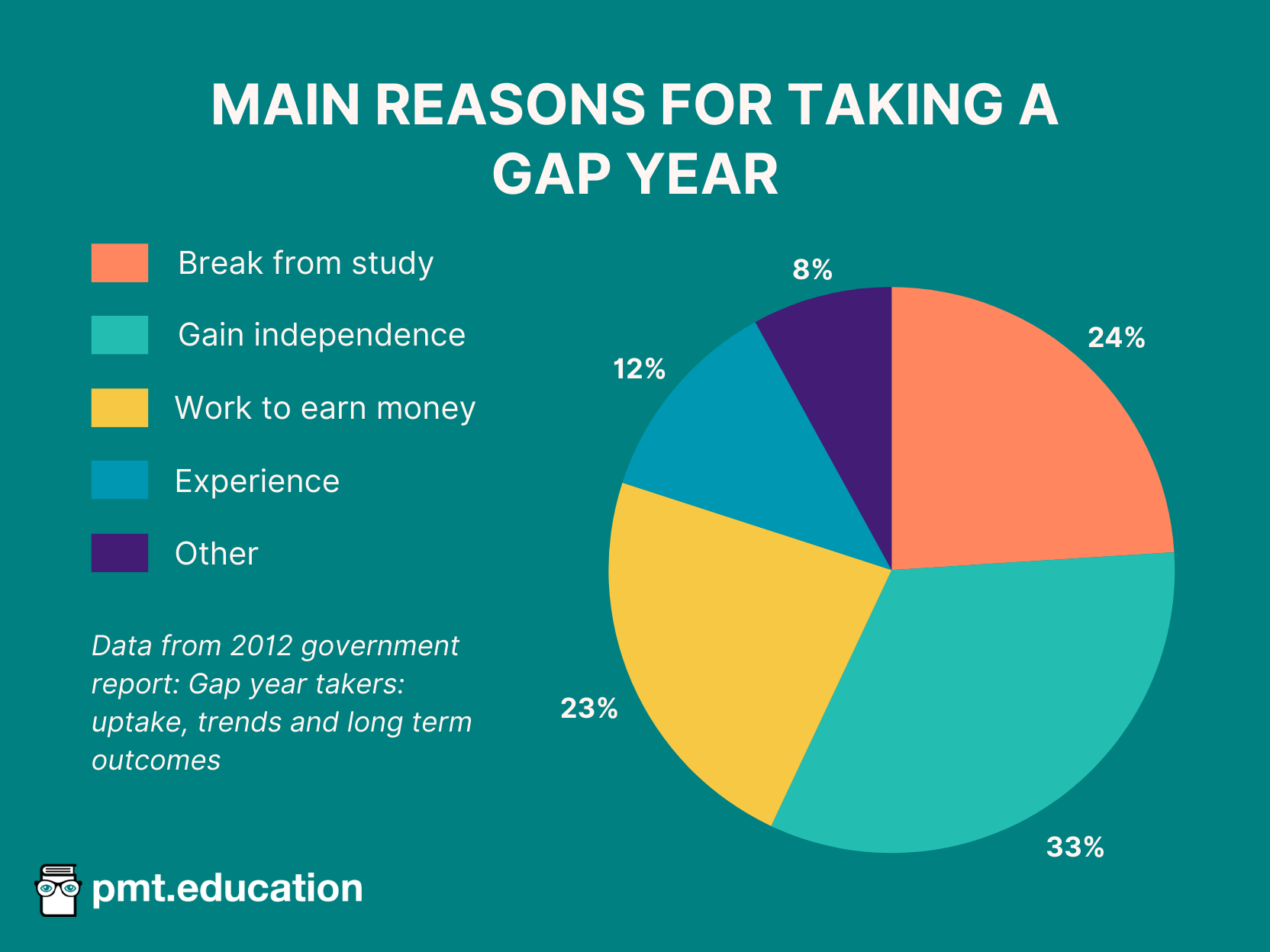Contents:
What is a gap year and who should take one?
Taking a gap year means taking a break from STEM education or work for a period of time. Anyone can take a gap year – STEM students and graduates included. Those who take a gap year often do so to travel, gain new perspectives, focus on other aspects of life, or simply recharge before diving back into their academic or professional STEM careers.
Despite what the name suggests, a gap year does not need to last exactly one year. You may need more time to achieve a time-consuming goal or less time to fit it in before the next stage in your career. The key thing to be mindful of is avoiding an unexplained gap in your CV. It’s important to be able to account for all your time with gap year experiences and explain their benefits.
STEM students are more likely to go straight to university and miss out on a gap year than other disciplines. Yet, a gap year has been shown to positively impact STEM university acceptance.
This article aims to explain why you, as a STEM student, can take a gap year, when the best time to take a gap year is, what you can do during your gap year and the benefits of a gap year to your future in STEM. By the end, you should feel confident about whether a gap year is right for you and have plenty of gap year ideas!
When can I take a gap year?
A gap year can be taken at various stages in your life, and more than once if you wish! The most common age range to take a gap year is 18–24 years old, with between 183,000 and 232,000 individuals in this age group taking a gap year in 2023. It’s important to choose the right timing for your gap year to avoid disrupting your academic or work life. The best time to take a gap year is typically during natural study breaks.

Here, you will find answers to the common questions surrounding taking a gap year at each of the three main natural study breaks in a typical STEM education:
1. Should I take a gap year before university?
A popular time for STEM students to take a gap year is after finishing secondary school and before starting their undergraduate degree. This means you should be in good company both on your gap year and once at university, with many other STEM students sharing gap year experiences and being of a similar age to you. Some common reasons for taking a gap year before university include: not feeling ready to leave home and friends, needing time to save money to fund university, and being unsure about your university choices.
You can take a gap year after submitting a UCAS application to university. If you have not been offered the university place you want, many students take a gap year to address any shortcomings in their application and reapply the following year. If you have received an offer, you can request to defer your start date but will need to provide a solid supporting explanation for doing so. Taking a gap year after submitting a UCAS application allows you to enjoy your gap year without the worry of applying to university. A larger percentage of gap year students go on to university if they have applied before their gap year than if they have not.
Can I take a gap year during university?
If you’re wondering whether you can take a gap year during university, you should instead consider taking one before starting. Universities often have strict policies regarding taking a gap year once you have started your course, making it uncommon. Alternatively, you could consider a placement year if you would like a recognised year out of your undergraduate study to work in STEM.
2. Should I take a gap year before postgraduate study?
The natural study break between undergraduate and postgraduate study is another great time to take a gap year. You can apply to your postgraduate course before or after your gap year, but it may be beneficial to apply after your break.
Longer gap years are more common at this stage, and deferred entry is usually restricted to one year. A gap year could help you find your niche for a research question for a master’s degree or explore career paths through vocational or conversion courses. Alternatively, it might be a chance to spend some time outside of STEM before fully committing PhD and a career in STEM academia.
Financial considerations are another popular reason for taking a gap year at this stage, as maintenance loans are not available for postgraduate degrees. Many students use this time to work and save money before continuing their education.

3. Should I take a gap year before starting work?
If you have finished your STEM studies (whether at university or secondary school) and are moving on to pursue your career, this could be another excellent time to take a gap year. Once in a professional STEM role, it is often harder to take a career break as workplaces provide incentives to remain within the field, working your way up the career ladder. Additionally, job contracts typically restrict holidays to an average of 28 days a year and getting permission for official leave for a gap year while employed could be difficult. Therefore, taking a gap year before starting work allows you to fulfil your goals outside of STEM, without hindering your professional development.
In fact, there are many benefits of a gap year before entering the workforce. Individuals will likely mature in their gap year, gaining the global awareness they need for the multicultural world of work, and developing key skills employers value.
If you are raring to go to university or to move on to postgraduate study then there will always be opportunities to take a gap year in the future.
Why take a gap year?
Beyond providing time to recharge after an intensive period of study, the benefits of taking a gap year at these natural study breaks include the opportunity to learn more about yourself, your goals, and your interests before pursuing the next chapter of your life in STEM.
It is extremely important to know why you are taking a gap year. This awareness will not only help you to plan what to do in your gap year effectively, but will enable you to explain the study break to universities and employers. Contrary to common concern, a gap year can be viewed positively by employers and universities, provided you can account for your time and evidence the benefits of taking a gap year.
Disadvantages and benefits of a gap year
There are many other benefits of a gap year, which form the varied reasons why people take one. The table below highlights some of the benefits of taking a gap year, alongside the disadvantages that some people report.
| Benefits of a gap year | Disadvantages of a gap year |
|---|---|
| Develop key transferable skills: From organisation, budgeting, and time management through travel, to self-motivation, discipline, and teamwork through employment | Finding valuable gap year experiences can be challenging |
| Create international connections: Having others who share your interests (in and out of STEM) can expose you to more opportunities in your STEM career | Both gap years in the UK or gap year travel may leave you feeling lonely if you are trying to pursue experiences alone (but organised programmes can help reduce this) |
| Become independent: Slowly adapt to being away from home and independent before experiencing this at university or work in a new location | Not going to university at the same time as the majority can be challenging, especially if you want to be with close friends for support (but there are plenty of others taking a gap year too!) |
| Fulfil a desire to explore: Becoming globally aware and breaking everyday routine | If you are driven by STEM and your studies or work, you may feel lost in your gap year or struggle to find other motivations |
| Take a break from study: Resetting to be in the best position to fully commit to the next step | Some people feel they forget their knowledge or find it hard to go back to the intensive learning that STEM demands after a break |
| Earn money: By working during a gap year, people can save to fund a STEM degree. | Gap years can be expensive and might leave you worse off financially if you do not work along the way |
| Explore your options: Discovering interests, gaining experience, and confirming your commitment to a field for entry into a STEM degree or job | People may be dissuaded from completing their STEM education as they discover other interests or priorities and studies show that those who took gap years earn less on average |
| Focus on other important matters: Elements of life outside of STEM, such as family, friends, health, and wellbeing | Still having home as your base during a gap year can be hard for those who wish to leave home sooner |

STEM gap year ideas
What you do in your gap year is usually determined by your reasons for taking it. The table below suggests some STEM gap year ideas:
Science residentials (e.g. biology camp)
Temporary work in your field of interest
Temporary work in your field abroad
STEM volunteering abroad
STEM gap year courses abroad
STEM internships (e.g. Sanger Institute)
Online STEM courses
Coding bootcamps
STEM gap year courses
What to do in a gap year with no money
If you’re wondering whether it’s possible to take a gap year with little to no money, this section is for you. A gap year doesn’t have to lead to financial strain. While traveling without working can be costly, there are plenty of more affordable options. For instance, volunteering often provides food and accommodation in exchange for work, significantly lowering your living expenses. Alternatively, working during your gap year allows you to earn money, which can help offset the costs of pursuing a STEM degree.
To earn money, you could take on temporary work either in the UK or abroad. While the job doesn’t need to be STEM-related to develop transferable skills for university, you might also consider seeking an entry-level or short-term position in STEM if it aligns with your interests.
To save money, volunteering offers an excellent option. Whether on farms, in hostels, or through other opportunities, it’s also a great way to connect with fellow gap-year travelers. The skills gained from coordinating these experiences, collaborating with others, and stepping outside your comfort zone are highly valued by STEM university admissions teams and employers alike.

For advice on how to budget if you want to backpack or travel without working, check out blogs articles from others who have been in similar situations.
How to plan your gap year around STEM
To benefit from a gap year the most you will need to formulate a solid plan for how this will fit into your STEM career path. Consider what you want to do in your gap year, what you want to gain from your gap year, and how you can demonstrate what you gained to a STEM employer or university.
You can be fully supported in your planning, either by opting for pre-organised gap year experience programmes or by seeking full support from gap year advisors. Alternatively, you can plan your gap year yourself with the wealth of resources available to help you.
Pre-organised STEM gap year experience programmes
For STEM gap years involving travel:
- Intern HQ: Offers international STEM internships for gap years
- Global work and travel: IT internships in Italy, volunteering on Darwin’s Galapagos Islands, and gap year courses, such as marine science in South Africa
- Projects Abroad: Volunteering programmes abroad, from medical internships in Peru and dentistry in Nepal to engineering in Sri Lanka
- International Citizen Service: Well-recognised volunteering opportunities abroad, including those combatting climate change and teaching science
- Go Overseas: Language courses abroad to develop your logical thinking
- Operation Wallacea: Conservation expeditions for biology students interested in ecology and conservation
- SALVE International: Data analysis programmes in Uganda
For STEM gap years in the UK:
- National Citizen Service: Well-recognised volunteering opportunities in any area that interests you or a paid year of service programme with employers in STEM
- Operation Wallacea: Wildlife field skills courses for those interested in careers in conservation

STEM gap year advisors
- SSA education: Offer advice on finding STEM gap year courses abroad
- Year Out Group: A professional body providing personal advice on planning your gap year
- WorkAway: Helps with self-organised volunteering opportunities by connecting you with individuals with similar interests in STEM across the globe who offer accommodation in exchange for work
- Thatch Travel: Connect with local experts who share your interests and offer personalised consultations to help you plan everything from backpacking adventures to shorter getaways.
Resources to plan your STEM gap year
- Our other STEM articles provide guidance on finding entry-level jobs, gaining work experience, exploring online courses, and joining coding bootcamps across the UK.
- NVCO: A list of UK volunteering opportunities
- Online blogs: Read about current STEM students’ experiences of taking a gap year
For volunteering and working abroad, you must ensure you have the correct visas and permissions to work in the country you are travelling to. Consider your safety, seek advice, and remember to get travel insurance! Some of the easiest countries to gain a working holiday visa for as a UK citizen are those in the commonwealth or Europe. There are plenty of resources and programmes available to support you with this process.
Planning your gap year: Checklist
- Weigh the pros and cons of a gap year to determine if it’s the right choice for you
- Decide when to take your gap year: before university, postgraduate study, or starting your career
- Consider your plans for after the gap year to ensure a smooth transition
- Choose activities for your gap year that align with your goals and motivations for taking one
- Reflect on the personal and professional benefits you hope to gain
- Determine the ideal duration of your gap year based on your plans and commitments
- Set a budget and explore options that fit within your financial constraints
- Research pre-arranged gap year programmes to find one that suits your interests
- Create a clear plan and seek advice from a gap year advisor, teacher, or carer
Is the gap year experience worth it?
This article has explored the advantages and disadvantages of taking a gap year in STEM, considering factors such as timing, activities, and personal circumstances. While a gap year isn’t suitable for everyone – particularly for those deeply immersed in STEM education who fear losing momentum – it can be a valuable opportunity for many. Stepping away from the structured STEM pathway can provide a chance to reflect, gain a broader perspective, and clarify your goals. By the end of your gap year, you may return to STEM with a clearer sense of purpose and more refined priorities.
Share in the comments where you are on your STEM journey and whether a gap year is part of your plans!

Comments